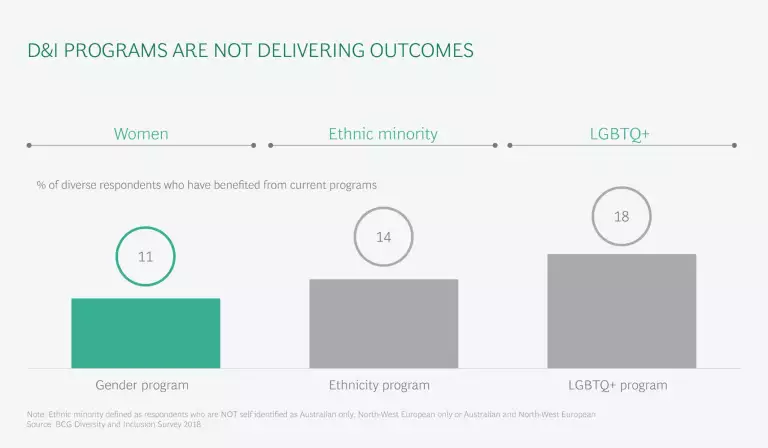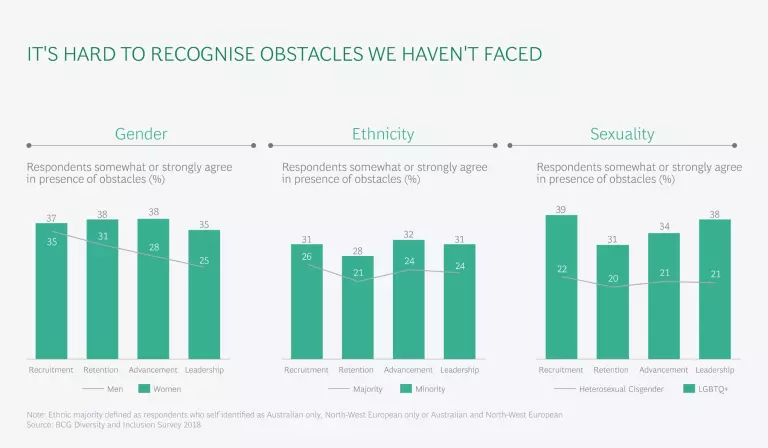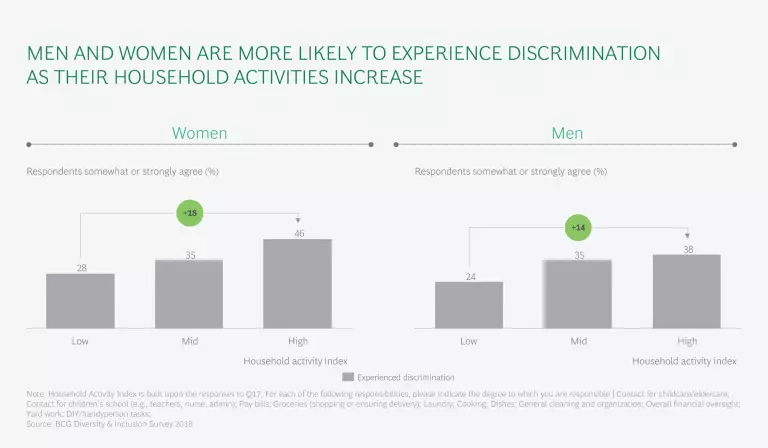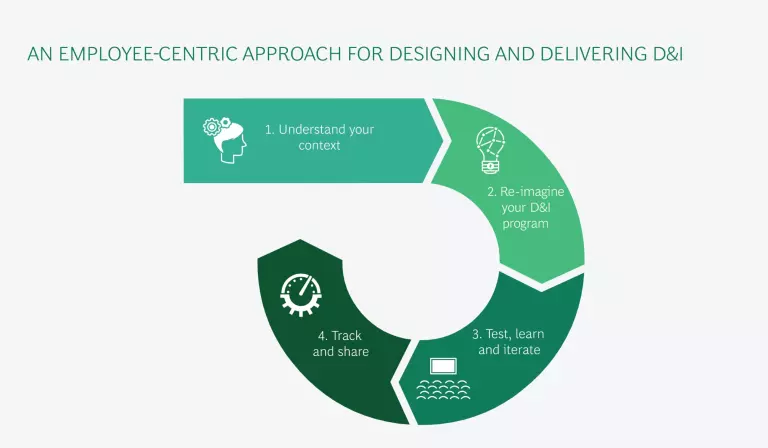Companies in Australia invest both time and money in diversity initiatives, yet most employees in diverse groups—women, ethnically diverse individuals, and LGBTQ+ employees—say they have not benefited. A key problem: the leaders at most organisations don’t understand the real-world obstacles that diverse employees face. These companies can start making real progress once they focus on the initiatives that diverse employees themselves say are effective. New BCG analysis, based on a comprehensive worldwide survey, shows how.
Of the 1,600 employees we surveyed, 97% reported that their company has at least one diversity and inclusion (D&I) initiative. Yet only 11% of women, 14% of ethnically diverse, and 18% of LGBTQ+ employees feel they have benefited from their company’s specific D&I programs. Despite efforts to change, more than 30% of employees report having experienced discrimination in the workplace. The obstacles are even greater for employees from diverse backgrounds and for those with care-giving responsibilities.
To deliver better outcomes, companies need to design and deliver D&I programs in a new way. Just as involving customers is critical to designing products that work, employees are critical to designing and delivering D&I programs that work.
Drawing on the experiences at leading Australian companies and our own research, we have developed a new approach to D&I—an employee-centric strategy.
Employees Have Limited Interaction with D&I Programs and Don't Feel Engaged
For employees to feel they benefit from their company’s D&I programs, they first need to be aware of and understand them. Only 32% of employees report direct exposure to their company’s D&I programs, and only 59% of employees say they understand the goals of these programs. Now that D&I programs are common, companies need to make sure their employees know about, understand, and have every opportunity to engage with and benefit from their D&I programs.
In Australia and around the world, issues of gender, LGBTQ+, and cultural and ethnic diversity permeate our collective consciousness. In response, companies have launched more D&I programs and increased participation in networks like Male Champions of Change and the same-sex marriage campaign. Nearly all the employees we surveyed (97%) report that their company has at least one D&I initiative, yet these initiatives have yielded surprisingly few outcomes.
Diverse Groups Perceive the Scale of the Challenges Very Differently
It is not surprising that people see things differently from their colleagues, but it is surprising just how differently they see them. The difference in views and experience is significant when considering who makes decisions about D&I programs.
One determinant of how people view D&I is their inherent diversity in gender, ethnicity, and sexuality. In Australia, these differences make it difficult for employees to recognise the obstacles that their colleagues may be facing across the employment life cycle. Employees who report the greatest difference are heterosexual cisgender, who struggle to see the obstacles that LGBTIQ+ employees face.
Effort Is Not Always Aligned With the Areas of Greatest Need
Employees at different life stages, who care for children or who have other home responsibilities, also have different experiences of discrimination and obstacles. Women and men who care for children experience discrimination at a higher rate than those who do not: 41% of women with children report having experienced discrimination compared with 34% of women without children, while 39% of men with children report having experienced discrimination compared to 27% of men without children. Employees with responsibility for household activities, regardless of their gender, sexuality, or ethnicity, are more exposed to discrimination in the workplace.
Our survey asked people to indicate the level of responsibility (i.e., primary, secondary, shared, some, outsourced, none) they have for household activities. These activities include being the contact for child care or elder care, grocery shopping, doing the laundry, cooking, cleaning, managing the household budget, and gardening. We aggregated the responses into an index that grouped people into high, medium, and low levels of household activity based on the number of activities for which they had primary responsibility.
What Are the Next Steps?
To start seeing real outcomes, we need to approach D&I in a new way. D&I strategies and programs must be designed, delivered, and rigorously executed based on the real-world obstacles facing diverse employees.
Our employee-centric approach has four steps:
- Understand your context: Run diagnostic exercises to understand your company’s D&I baseline, and design a scorecard to set your goals for progress.
- Reimagine your D&I program: Engage a diverse group of employees to find the right solutions for your organisation’s environment and people.
- Test, learn, and iterate: Do not “set and forget” D&I programs—test and learn to find out what works and iterate to continue improving.
- Track and share: Track progress against the scorecard and share progress widely.












